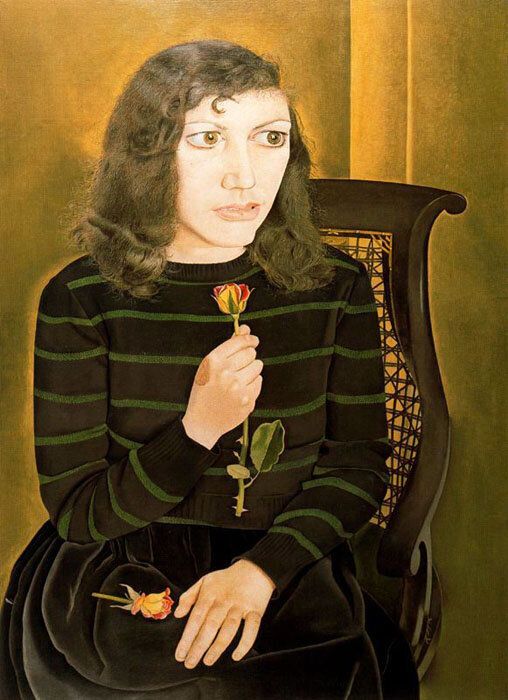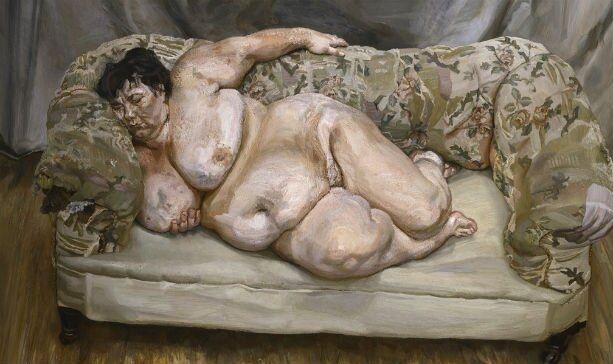There's a telling photograph in the National Portrait Gallery's Lucian Freud retrospective of David Hockney sitting poised on a stool in Freud's studio. The elder Hockney looks like a man at peace, his glasses perched on his nose giving him a grandfatherly air. Freud, by contrast, is hunched, standing in a doorway splattered with paint. Despite his age, he has the air of a fighter; his legs apart as he grips his tools. Gentle Hockney is about to be interrogated under Freud's eye. This gaze follows us throughout the exhibition; the intense focus of Freud revealing a world of flesh and form.
As with Freud the psychoanalyst and Freud the public relations man, one would expect Freud the painter to be equally adept at analysing the human condition. While Lucian dismissed ideas that people should apply the same complex rules of meaning to his paintings as his grandfather had to dreams, it's easy to see the relationship. While a white dog is often just that in Lucian's work, his earlier pieces encourage the viewer to pick the symbols apart. Man with a Feather, for example, was painted during the Second World War after the Freuds had fled Nazi persecution. It shows a young Freud standing in a barren landscape clasping a white feather with a black crow perched behind him. It's not a huge leap of the faith to suggest these are symbols for cowardice and death. Similarly, with Girl with Roses we see Freud's future wife, Kitty Garman, grasping of a vibrant rose. The image is almost medieval: cold and formal and heavy with symbolic meaning.

© The Lucian Freud Archive. Photo: Courtesy Lucian Freud Archive
Freud consistently shows an interest in hidden psychological currents; what he described as the 'inner lives' of subjects 'ticking away'. Yet in stripping them back to their naked essence we are often left with subjects not only void of clothing, but even individual identity or humanity. Bodies are often reduced to mere animalistic forms. We can touch, feel and smell them, but it's hard to imagine communicating with them on any other level. It very quickly ceases to matter about the names or positions of subjects and we become faced with the primeval reflections of a man who had meditated deeply on the human form. Freud himself noted he was 'inclined to think of "humans"...if they're dressed as animals dressed up'. Often - although never completely - bodies seem to lack any inner life. The famous 'Big Sue', for example, is asleep, betraying no inner life, save perhaps for a lethargic peace. Yet Freud may have tipped from painting a person, into painting a form: a series of shapes, colours and textures.

© The Lucian Freud Archive. Photo: Courtesy Lucian Freud Archive
Often the dominant personality in the room is not the sitter at all, but the artist. There are several contorted forms, for example, that meekly look away from our view, seemingly consumed by some internal anxiety or unease. Freud's presence is often unbearable; he looms and adds a psychological uneasiness and intensity to what initially appears to be a simple nude. Indeed his raptor like gaze, under which subjects could sit for hundreds of hours, is penetrating. To return to the primeval idea, the artist is the hunter, merging with his environment and often becoming an extension of his surroundings. Harry Diamond noted the consuming nature of sitting for Freud: 'if someone is interested in getting your essence down on canvas, they are also drawing the essence out of you.' Freud's subjects frequently resonate a defensive tone; a body caged and shrinking from the sharpened tools of the painter.

© The Lucian Freud Archive. Photo: Courtesy Lucian Freud Archive
Nevertheless some of his subjects stand out as strong personalities - aware of themselves and their bodies and confident in both. His painting of his daughter Bella is direct and confident in tone, and is one of mutual respect and understanding. Similarly with subjects like Leigh Bowery, an Australian performance artist, the sitter does not buckle under Freud's gaze but joins in the creative process, adding an interesting element to the paintings; perhaps objectifying the project more for Freud whose portraits often take on a one sided autobiographical tone.
Perhaps this is taking the psychological analysis too far. Freud was often reclusive, yes, but is frequently described as affectionate, gentle and witty. With many of his paintings he simply attempted to project the same drama and theatrical movements borrowed from the Old Masters. We do not over-analyse what the contorted forms of Daphne transforming herself can tell us about various artists - why do the same with Freud? Lucian borrowed quite openly from Watteau or Manet, for example and was, at root, a brilliant artist and draughtsman rather than a psychologist. That we search for something else, simply highlights how much the twentieth-century has become 'Freud's' century.
Lucian Freud Portraits is currently showing at the National Portrait Gallery until 27 May.

© The Lucian Freud Archive. Photo: Courtesy Lucian Freud Archive